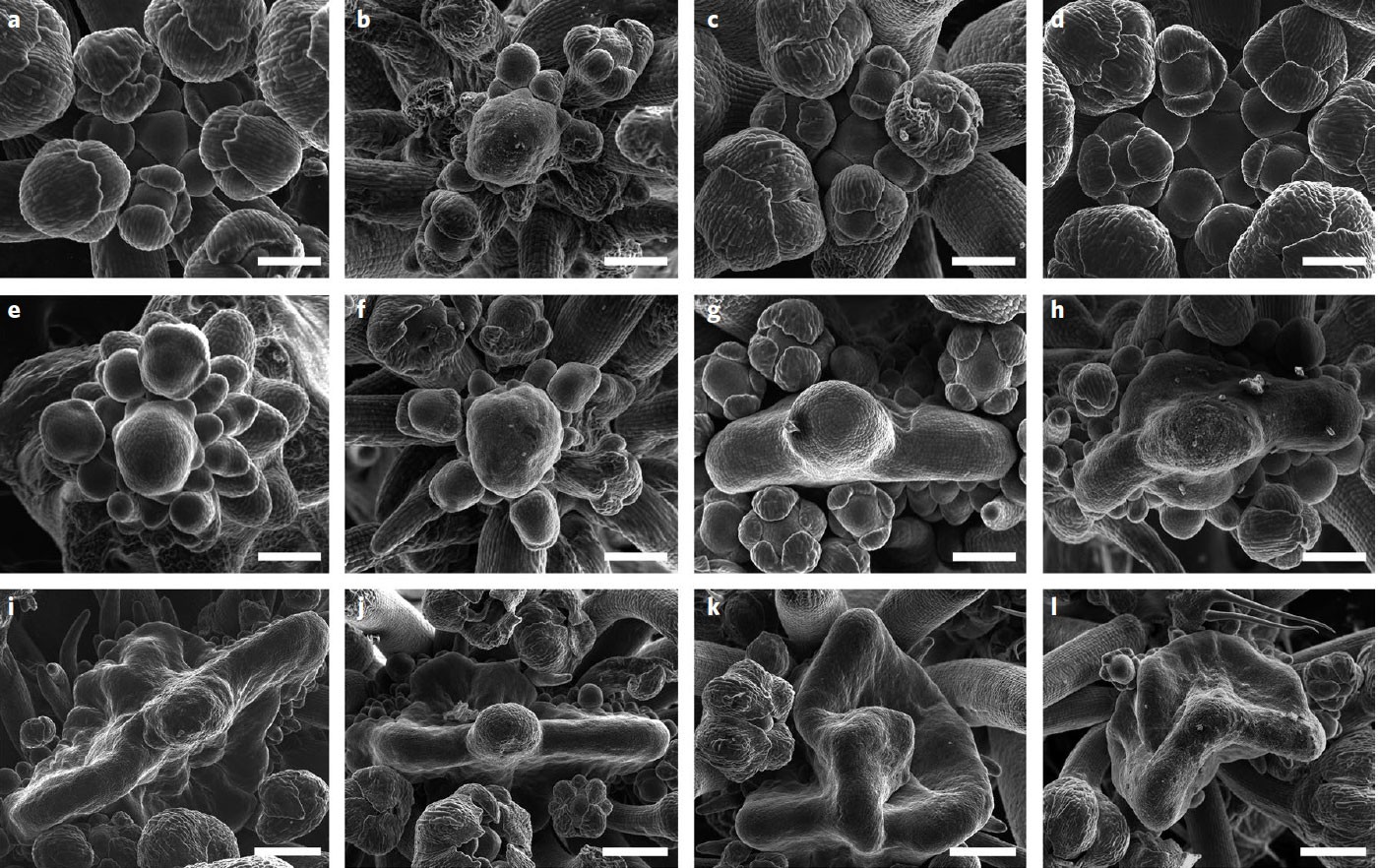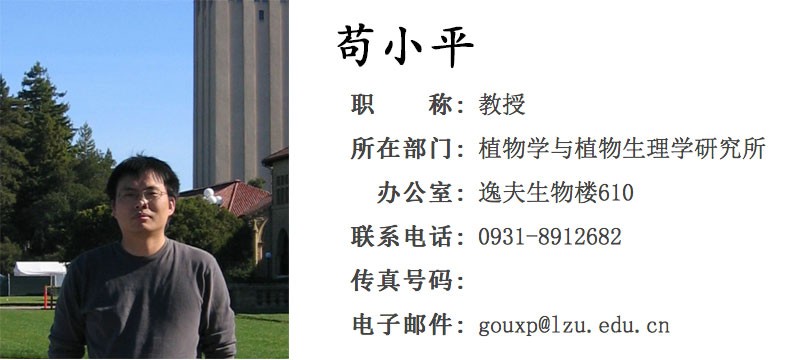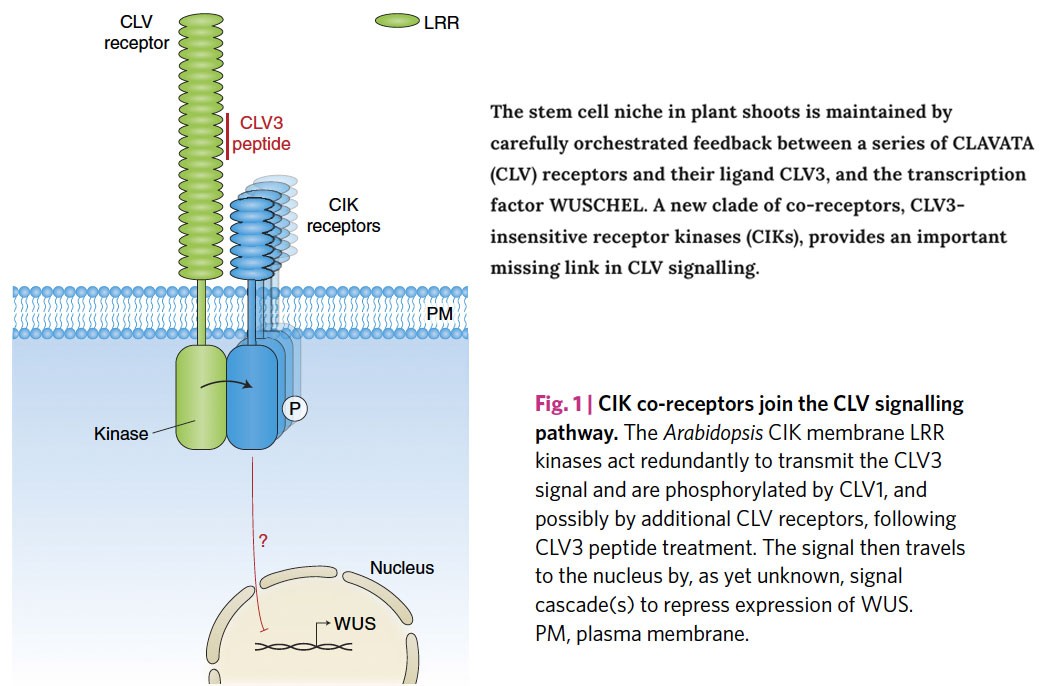博文
Nature Plants:干细胞调控CLAVATA–WUSCHEL通路新成员CIKs
||
A group of receptor kinases are essential for CLAVATA signalling to maintain stem cell homeostasis
First author: Chong Hu; Affiliations: Lanzhou University (兰州大学): Lanzhou, China
Corresponding author: Xiaoping Gou (苟小平)
Continuous organ initiation and outgrowth in plants relies on the proliferation and differentiation of stem cells maintained by the CLAVATA (CLV)–WUSCHEL (WUS) negative-feedback loop (负反馈回路). Leucine-rich repeat receptor-like protein kinases (LRR-RLKs; 富含亮氨酸重复类受体蛋白激酶), including CLV1, BARELY ANY MERISTEMS and RECEPTOR-LIKE PROTEIN KINASE 2 (RPK2; 类受体蛋白激酶), a receptor-like protein CLV2 and a pseudokinase (假激酶) CORYNE (CRN) are involved in the perception of the CLV3 signal to repress WUS expression. WUS, a homeodomain transcription factor, in turn directly activates CLV3 expression and promotes stem cell activity in the shoot apical meristem (SAM; 茎尖分生组织). However, the signalling mechanism immediately following the perception of CLV3 by its receptors is poorly understood. Here, we show that a group of LRR-RLKs, designated as CLAVATA3 INSENSITIVE RECEPTOR KINASES (CIKs; CLV3不敏感受体激酶), have essential roles in regulating CLV3-mediated stem cell homeostasis. The cik1 2 3 4 quadruple mutant exhibits a significantly enlarged SAM, resembling (类似) clv mutants. Genetic analyses and biochemical assays demonstrated that CIKs function as co-receptors of CLV1, CLV2/CRN and RPK2 to mediate CLV3 signalling through phosphorylation (磷酸化). Our findings not only widen the understanding of the underlying mechanism of CLV3 signal transduction in regulating stem cell fate but also reveal a novel group of RLKs that function as co-receptors to possibly mediate multiple extrinsic and intrinsic signals during plant growth and development.
植物中连续的器官起始和生长取决与干细胞的增殖和分化,而干细胞主要是通过CLAVATA–WUSCHEL负反馈回路来维持的。包括CLV1、BAM、RPK2、CLV2和CRN等在内的富含亮氨酸重复类受体蛋白激酶LRR-RLKs参与了对CLV3信号的感知到抑制WUS基因的表达。WUS,是一类同源结构域转录因子,反过来直接激活CLV3的表达,并促进茎尖分生组织SAM中干细胞的活性。然而,在CLV3被其受体感知之后的信号转导机制还是一个谜团。本文鉴定了一类LRR-RLKs,定义为CLV3不敏感受体激酶CIKs,其具有调控CLV3介导的干细胞内稳态的作用。cik1 2 3 4四突变体存在显著增大的SAM结构,这种表型类似于clv突变体的表型。遗传分析和生化分析显示CIKs作为CLV1,CLV2/CRN和RPK2的共受体,通过磷酸化调控CLV3信号转导。本文的研究不仅拓宽了对于干细胞调控中CLV3信号转导分子机制的理解,同时还揭示了一类新的可以作为共受体的RLKs,可能在植物生长发育过程中介导着多个体内体外信号途径。
通讯:苟小平 (http://lifesc.lzu.edu.cn/t/gouxiaoping_302.html)
�
�个人简介:1991-1995年,四川大学,植物学学士;1995-1998年,四川大学,植物学硕士;1998-2001年,四川大学,植物学博士;2001-2009年,俄克拉何马大学,微生物学与植物生物学系博士后;2009-至今,兰州大学,生命科学学院教授/博导。
研究方向:受体激酶介导的细胞信号转导;植物生殖生物学。
doi: 10.1038/s41477-018-0123-z
Journal: Nature Plants
Published date: 26 March, 2018
Learning from CIK plants
First author: Fang Xu; Affiliations: Cold Spring Harbor Laboratory (冷泉港实验室): NY, USA
Corresponding author: David Jackson
The beauty of plants is inherent (内在的) in their intricate (复杂的) geometries (几何), such as the precise Fibonacci spirals (斐波纳契数列螺旋) of a sunflower head that are immediately distinguishable from the simple linear architecture of a tall grass, yet how are these patterns generated? Plant survival depends on pools of stem cells, called meristems, that maintain an organized stem cell niche (干细胞龛) throughout the life of the plant, and initiate the regular geometrical patterns (几何构型) of organs that are critical to plant survival. The textbook CLAVATA–WUSCHEL (CLV–WUS) model was first established 18 years ago, however the signalling events downstream of the CLV receptors, and especially the targets of the leucine-rich repeat (LRR) CLV1 receptor-like kinase (RLK), have remained largely a mystery. In other LRR–RLK signalling pathways in plants, receptors associate with shorter co-receptors, such as the BAK/SERK receptor kinases. In this issue of Nature Plants, Hu et al. report a brute force reverse genetic screen to investigate the functions of additional members of the BAK/SERK clade of LRR kinases.
Not surprisingly, many of the knockouts generated had no obvious phenotype because of genetic redundancy. However, the authors found some triple or quadruple mutant combinations with severely enlarged meristems and fasciated (扁化的) stems, reminiscent (让人想起) of clv mutants. Looking at expression of CLV3 and WUS in the mutants, it was obvious that the intricate stem cell feedback was broken, as both were expressed in expanded and disorganized domains. To determine if the new mutants were acting in the CLV pathway, a simple trick was used whereby plants were treated with synthetic CLV3 peptide. In normal plants, this saturates the negative feedback on WUS, terminating (终止) the stem cell niche and arresting (阻止) shoot growth. Remarkably, however, the quadruple mutant plants were unaffected by CLV3 peptide. These results were backed up using epistasis tests (上位显性测试), where it was found that the quadruple mutant phenotypes were no more severe when combined with mutations in known CLV receptors. Together, these findings place these new candidate co-receptors firmly (坚定地) in the CLV pathway, and they were therefore named ‘CIKs’ for CLV3-insensitive receptor kinases.
How do CIKs contribute to CLV signalling? A series of interaction assays both in yeast and in plants found that they interact directly with all known CLV receptors. These receptor interactions were very stable, and not affected by CLV3 ligand treatment. However, it was exciting to see that CIK phosphorylation (磷酸化) was rapidly induced by treating plants with CLV3 for just 10 min, and that CLV1 could phosphorylate CIKs in vitro. Therefore, a new model of the CLV3 signal transduction pathway emerges, whereby binding of CLV3 to CLV1 induces rapid phosphorylation of CIK co-receptors (Fig. 1). CIKs, like CLV receptors, are on the plasma membrane (质膜), so this is only one small step for the pathway, but one giant leap in understanding for meristem biologists. Of course, many new experiments are now possible and it will be interesting to test the effect of blocking CIK phosphorylation in vivo, and of course to walk further downstream to ask what further steps connect CIKs to WUS.
�
�So, not surprisingly, nature is more complex than we expected, and it is interesting to speculate why some gene families, like the CIKs, are so highly redundant, whereas others have strong phenotypes when only one member is mutated. The textbook CLV–WUS pathway would have been impossible to deduce 18 years ago if CLV3 and/or WUS had redundant paralogues, for example. One reason for such apparent redundancy may be that different paralogues actually perform distinct functions under specific conditions. For example, relatives of the CIKs function in virus resistance, and another recent report showed that mutants in BARELY ANY MERISTEM (BAM) genes, which are partially redundant homologues of CLV1, are also impaired in spread of viruses as well as of small RNAs. Therefore it seems likely that CIK-related co-receptors also function with BAM receptors in viral defence and possibly in small RNA signaling.
While we find out more about the intricacies of receptor kinase signaling in stem cell control in plants, it is also important to consider how this knowledge may be of practical use. Subtle manipulation of CLV pathway genes can lead to meristems that do not proliferate uncontrollably, like strong clv or cik mutants, but are just a little bit bigger, allowing production of bigger fruits in tomato or more seeds in maize. CIKs are now obvious candidates for similar manipulation and may lead to enhanced crop productivity.
A long-standing mystery in plants has been why there are so many transmembrane kinase receptors, especially in the LRR class. Another recent study characterized the LRR receptor interactome that provides a framework for understanding how different LRR–RLK classes, such as CLV and CIK, work together in signal transduction. Seventeen years ago, when the enormity (巨大) of the LRR kinase family was realized, it was a daunting (艰巨的) task to tackle such a large group of genes with obvious deep redundancy. However, with the new tool of CRISPR–Cas9, multiplex knockouts can now be made routinely, and hopefully the mystery of why plants carry so many receptors can be solved in the near future.
通讯:David Jackson (https://www.cshl.edu/research/faculty-staff/david-jackson/)
�
�研究方向:植物生长和发育相关的细胞内基因和信号转导。
doi: 10.1038/s41477-018-0125-x
Journal: Nature Plants
Published date: 26 March, 2018
(P.S. 欢迎关注微信公众号:微信号Plant_Frontiers)
https://blog.sciencenet.cn/blog-3158122-1106028.html
上一篇:TRENDS PLANT SCI:植物再生过程中的表观动态变化(综述)
下一篇:Developmental Cell:拟南芥生物钟通过细胞周期调控植物生长
全部作者的其他最新博文
- • Plant Physiology:CsMADS3促进柑果中的叶绿素降解和类胡萝卜素合成(华中农业大学)
- • Molecular Plant:LBD11-ROS反馈调节作用于拟南芥的维管形成层增殖和次生生长(浦项科技大学)
- • Science Advances:根结线虫通过调控植物的CLE3-CLV1模块,促进侵染进程(日本熊本大学)
- • Nature Communications:油菜素内酯参与植物营养生长期转变的分子机制解析(浙江农林大学)
- • Current Biology:光合作用产生的蔗糖驱动侧根“生物钟”(德国弗莱堡大学)
- • PNAS:花同源异型基因在叶中被抑制、花中被激活的分子机制(南卡罗来纳大学)



